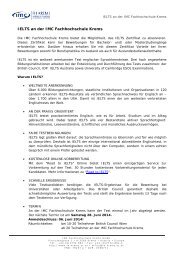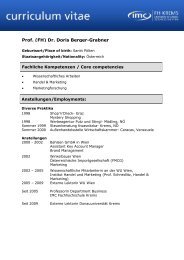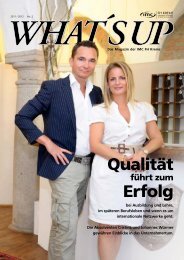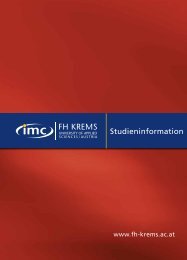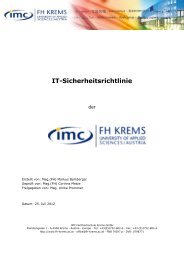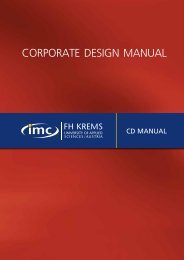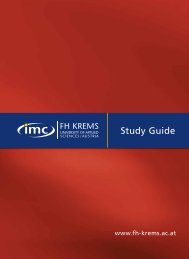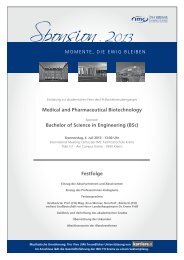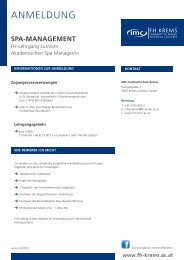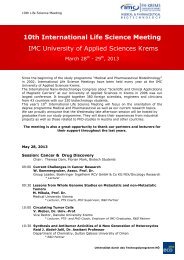General Laboratory Safty Rules
General Laboratory Safty Rules
General Laboratory Safty Rules
You also want an ePaper? Increase the reach of your titles
YUMPU automatically turns print PDFs into web optimized ePapers that Google loves.
<strong>General</strong> Handbook for <strong>Laboratory</strong> Safety<br />
Department for Medical and Pharmaceutical<br />
Biotechnology<br />
Krems, Austria, December 2012<br />
Dok.Nr.: FHR-1-0036<br />
Version 02_Revision 00<br />
Approved by: Prof(FH) Mag. Dr. Harald Hundsberger
Content<br />
Content .............................................................. Fehler! Textmarke nicht definiert.<br />
1 Special responsibilities ......................................................................................... 3<br />
1.1 Officer for biological safety and officer for chemical safety ........................................ 3<br />
1.2 Lecturers and Project heads ............................................................................ 3<br />
1.3 Bachelor- und Master Students, Ph.D students ..................................................... 3<br />
1.4 Cleaning personnel and technical support staff ..................................................... 4<br />
1.5 Visitors...................................................................................................... 4<br />
1.6 Head of <strong>Laboratory</strong> ....................................................................................... 4<br />
1.7 Facility Services ........................................................................................... 4<br />
1.8 Officer for chemical safety............................................................................... 4<br />
1.9 Biological Safety Officer, BSO and Biosafety Committee, BSC ................................... 5<br />
1.10 Head of the department and carrier ................................................................... 5<br />
2 <strong>General</strong> Lab instructions ....................................................................................... 5<br />
2.1 Work with chemicals and toxic substances / waste disposal / manipulation of spilled liquids /<br />
first aid ............................................................................................................... 5<br />
2.2 Work with biological agents / waste disposal / manipulation of spilled liquids .................. 5<br />
2.3 Working with pressurized gas .......................................................................... 5<br />
2.3.1 Storage, transport and handling .................................................................. 5<br />
2.3.2 Inspection of pressurized gas bottles, save connection and safe operation .............. 6<br />
2.4 Using of glass equipment ............................................................................... 6<br />
2.5 Working with lab equipment in laboratories .......................................................... 6<br />
3 Maintenance of equipment ..................................................................................... 6<br />
3.1 <strong>General</strong> <strong>Laboratory</strong> equipment ......................................................................... 6<br />
3.2 Portable lab equipment .................................................................................. 6<br />
4 Lab safety rules for students .................................................................................. 7<br />
4.1 Safety rules for working in the laboratory ............................................................. 7<br />
4.2 Working out of standard hours of work ................................................................ 8<br />
5 Emergency action ............................................................................................... 9<br />
5.1 Accidents in a lab ......................................................................................... 9<br />
5.1.1 Place of the first aid box ........................................................................... 9<br />
5.1.2 First aid personal in the department for Medical and Pharmaceutical Biotechnology ... 9<br />
5.2 Fire alarm and Evacuation .............................................................................. 9<br />
5.3 Gas bottles when fire..................................................................................... 9<br />
5.4 Escape of gas ............................................................................................10<br />
5.5 Persons to be informed in case of emergency ......................................................10<br />
Doc.Nr.:FHR-1-0036_Vers.02_ Rev.00_E<br />
2
1 Special responsibilities<br />
1.1 Officer for biological safety and officer for chemical safety<br />
Both officers have to keep the instruction material for their area updated. All updates<br />
have to be verified. Both officers have to train Lecturers, Scientific staff and students<br />
according to the training matrix. The signature lists are to be kept by the officers for<br />
biological and chemical safety. Additionally these lists have to be scanned and are to be<br />
stored:<br />
\\dachstein\Forschungslaufwerk_Biotechnologie\Biologische-Chemische-<br />
Sicherheit\Qualitätsmanagement Sicherheit Bio\Dokumentation<br />
1.2 Lecturers and Project heads<br />
Lecturers and project heads are responsible for safe planning and implementing of lab<br />
experiments. During lab courses with Bachelor- and Master Students special attention is<br />
to be taken regarding health and safety. Lecturers are responsible to ensure that all<br />
students and project staff is trained and that this training was verified by signature. The<br />
instruction material has to be placed on the e-desktop and this link has to be added to<br />
the syllabi to ensure that all students and scientific staff have attendance to this<br />
information. After the training students have to sign the attendance list to confirm that<br />
they received the training (additional information you find in the instructions „Umgang<br />
mit Chemikalien und Giften“ and „Handbuch für biologische Sicherheit“)<br />
Lecturers are responsible to keep the laboratories ordered and clean:<br />
<br />
<br />
<br />
<br />
<br />
<br />
<br />
<br />
No loose cables as tripping hazards<br />
When liquids are spilled they have to be mopped up immediately under<br />
consideration the nature of the liquid<br />
Passages have to be kept free<br />
Not used chemicals, microorganisms and lab equipment have to be brought<br />
back to the intended storage place.<br />
Disposal of waste has to be ensured (additional information: „Umgang mit<br />
Chemikalien und Giften“ and „Handbuch für biologische Sicherheit“).<br />
Waste has to be separated as soon as possible. Garbage containers have to<br />
be brought to the intended storage areas as soon they are full. Overfilling<br />
of the containers has to be avoided.<br />
Lock valves for gas and water have to be closed at the end of each working<br />
day. The ice-machine may be kept turned on if necessary.<br />
All windows and doors have to be closed at the end of each working day.<br />
Lamps, computers and lab equipment have to be turned off at the end of<br />
each working day. Equipment that has to be turned on to run an<br />
experiment may be kept turned on.<br />
Lecturers and project heads are responsible to inform the person responsible for the lab<br />
in case of damage or breakdown of equipment during the execution of an experiment.<br />
1.3 Bachelor- und Master Students, Ph.D students<br />
Students and scientific staff have to memorize (http://edesktop.fhkrems.ac.at/programmes/biotech/safety/Documents)<br />
prior a lab course or<br />
during scientific work the safety instructions. During pre-lab meetings lecturers have to<br />
advise the students that during lab work they have to work responsible and always have<br />
to follow health and safety instructions. Based on the instruction manuals students have<br />
to refresh their knowledge about the location of the safety showers, eye showers, and<br />
equipment for mopping spilled liquids, fire extinguishers, fire blankets, first aid stations,<br />
info boards, exits and general lab rules.<br />
Doc.Nr.:FHR-1-0036_Vers.02_ Rev.00_E<br />
3
During safety instructions students are advised to inform the head of the department, or<br />
in case of lack of time, the lecturer about: allergies, pregnancy.. . Sufficient protective<br />
measure is only possible if they are known.<br />
During the practical work students have to follow the instructions of the lecturers and<br />
scientific staff in all details.<br />
In case of accidents students have to report them to the staff immediately. Additionally<br />
students have to support the compiling of reports to the insurance.<br />
In case of non-compliance of lab rules the lecturer has to suspend the student due to<br />
safety issues.<br />
1.4 Cleaning personnel and technical support staff<br />
Cleaning personnel and technical support staff conducting cleaning, maintenance or<br />
installations in the laboratories of the department for Medical and Pharmaceutical<br />
Biotechnology have to have the permission of the department head, the head of the<br />
degree program or the person responsible for the lab.<br />
Facility service is responsible to ensure that all relevant instructions done by authorized<br />
persons are done prior above mentioned personnel is allowed to enter the lab. The<br />
attendance of the training is confirmed by a signature in signature lists. These lists are<br />
stored<br />
(\\dachstein\Forschungslaufwerk_Biotechnologie\Biologische-<br />
Chemische-Sicherheit\Qualitätsmanagement Sicherheit Bio\Dokumentation ).<br />
1.5 Visitors<br />
Prior entering the lab visitors have to watch the training video to get familiar to general<br />
lab rules. Visitors must not enter the labs without staff of the department of Medical and<br />
Pharmaceutical Biotechnology. Further details can be found in the training matrix.<br />
1.6 Head of <strong>Laboratory</strong><br />
The head of laboratory has the general responsibility for the lab. This includes the<br />
organization of proper maintenance of lab equipment, storage of chemicals and material.<br />
To ensure the safety of students lecturers have to discuss safety issues with the head of<br />
the laboratory prior lab courses.<br />
1.7 Facility Services<br />
Facility Services is responsible for maintaining the safety equipment in the laboratories,<br />
the first aid equipment, the safety showers, eye showers, equipment for mopping spilled<br />
liquids and fire extinguishers. Facility Services has to replace used fire extinguishers.<br />
1.8 Officer for chemical safety<br />
The officer for chemical safety is responsible for compiling and adhering of instructions<br />
regarding the save handling of toxic substances at the department for Medical and<br />
Pharmaceutical Biotechnology. This responsibility includes all safety aspects related with<br />
dangerous chemical and biochemical substances including the insurance of safe storage<br />
and the implementation if necessary preventive and safety actions when working with<br />
chemicals.<br />
The guideline for working with toxic substances, CMR-substances can be found in the<br />
instruction „Umgang mit Chemikalien und Giften“.<br />
Doc.Nr.:FHR-1-0036_Vers.02_ Rev.00_E<br />
4
1.9 Biological Safety Officer, BSO and Biosafety Committee, BSC<br />
The BSO has to inspect the abidance of the safety rules in laboratories on a routine base.<br />
In case of deficiencies this has to be discussed with the involved head of the laboratory<br />
and the project head. All activities have to be documented.<br />
Additionally the BSO has to develop a plan for training of the staff members and students<br />
to ensure safety in terms of the usage of GMO. All activities have to be documented.<br />
The KBS is composed of the BSO, an two internal Lecturer of the IMC and an external<br />
expert. The KBS has to have at least once a year a meeting. During this meeting the<br />
compliance in terms of safety has to be reviewed (see „Handbuch biologische<br />
Sicherheit“). New organisms have to be discussed and classified according to the risk<br />
assessment.<br />
1.10 Head of the department and carrier<br />
The Head of the department and carrier have to ensure that the BSO and the officer<br />
for chemical safety are supported and have enough time during their working time for<br />
qualification and time for discussion with project leaders regarding safety issues.<br />
2 <strong>General</strong> Lab instructions<br />
2.1 Work with chemicals and toxic substances / waste disposal / manipulation<br />
of spilled liquids / first aid<br />
Detailed information can be found in the instruction manual „Umgang mit Chemikalien<br />
und Giften“.<br />
2.2 Work with biological agents / waste disposal / manipulation of spilled<br />
liquids<br />
Detailed information can be found in the instruction manual „Handbuch für biologische<br />
Sicherheit“<br />
2.3 Working with pressurized gas<br />
All users have to know the properties of the used gases and have be familiar with the<br />
used equipment therefor. The safety data sheets for the used gases and the work<br />
instructions for the equipment have to be stored at the point of use. The gas bottles are<br />
according to the regulations, classifications and packaging for dangerous goods labeled.<br />
Gas bottles only are allowed to be used if the labeling is clear. Identification is done by<br />
using the accompanying documents. After checking the accompanying documents and<br />
hereby the check for correct color labeling gases are allowed to be used. Incorrectness<br />
have to be marked on the gas bottles.<br />
2.3.1 Storage, transport and handling<br />
<br />
<br />
<br />
<br />
All personnel working with gas bottles have to use safety goggles, safety gloves<br />
and have to avoid loose clothing<br />
Oxygen must not be stored close to flammable material. The distance between<br />
oxygen and flammable has to be at least 3 meters or a fire protection wall<br />
When using or storing toxic gases in gas bottles the protection cap has to be<br />
placed as soon as the gases are not in use.<br />
Gas bottles have to be transported with appropriate transport systems. Valves<br />
have to be closed and the protection cap has to be in place. Gas bottles in use<br />
have to be positioned upwards and fixed by chains or similar devices.<br />
Doc.Nr.:FHR-1-0036_Vers.02_ Rev.00_E<br />
5
Lab equipment (flow regulators, tubing, Bunsen burner) have to be removed prior<br />
transport or storage of gas bottles. Gas bottles have to be stored at a determined<br />
controlled place<br />
2.3.2 Inspection of pressurized gas bottles, save connection and safe operation<br />
<br />
<br />
<br />
<br />
<br />
<br />
The labeling of gas bottles has to be controlled by using the accompanying<br />
document to ensure that the bottle is filled with the correct gas<br />
Prior connection of the system to the gas bottles it has to be verified that the<br />
system can withstand the supplied pressure. When using gases with lab<br />
equipment you have to follow the user’s manual<br />
The opening of the manual gas valve has to be done slowly. The direction is<br />
indicated by arrows in the hand wheel. In case is nonuse for longer time the<br />
manual valve has to be closed.<br />
Pressure reducing valves have to withstand the pressure in the gas bottles<br />
To avoid mix-ups between flammable gases and nonflammable gases the screw<br />
thread are running in different directions. For nonflammable gases the screw<br />
thread runs into right, for flammable gases it runs left. Non fitting connections<br />
must not be forced; flow regulators must not be modified.<br />
To avoid flame flash back gas bottles for Oxygen, Acetylene, Propane, Hydrogen<br />
have to be fitted with a flame arrester.<br />
2.4 Using of glass equipment<br />
Many lab accidents and the resulting injuries result from handling glassware. Accidents<br />
are not just dangerous themselves; additionally they can be an entrance port for toxic<br />
substances or biological material. Prior use of glass equipment it has to be checked on<br />
cleanliness and integrity. Broken glassware has to be indicated to the lecturer. Mending<br />
of damaged glassware has to be done by trained and competent personnel. Disposal of<br />
damaged glassware has to be done into containers labeled by „Nur für zerbrochene<br />
Glasbehälter“.<br />
2.5 Working with lab equipment in laboratories<br />
Everyone using lab equipment has to have appropriate training by the responsible<br />
institute member. User’s manuals for the lab equipment have to be placed in the<br />
respective laboratories. User´s manuals plus the instruction of the academic personnel<br />
have to be followed.<br />
Prior usage of equipment the responsible staff member has to be asked and the<br />
respective users. The users log has to be verified to ensure that all defects are reported<br />
and tracked.<br />
3 Maintenance of equipment<br />
3.1 <strong>General</strong> <strong>Laboratory</strong> equipment<br />
Maintenance of lab equipment has to be done according to maintenance plans. Type of<br />
maintenance is determined in the user’s manual or, if not determined there, determined<br />
by the person responsible for this equipment. Maintenance has to be done twice a year or<br />
as determined in the maintenance plan by the vendor. All inspections, detected faults,<br />
performed corrections and test results have to be collected in the maintenance reports.<br />
3.2 Portable lab equipment<br />
All equipment is taken to stock and at least once a year checked apparently by the<br />
responsible person for the lab. Reports are to be stored:<br />
\\dachstein\Forschungslaufwerk_Biotechnologie\Biologische-Chemische-<br />
Sicherheit\Qualitätsmanagement Sicherheit Bio\Dokumentation.<br />
Doc.Nr.:FHR-1-0036_Vers.02_ Rev.00_E<br />
6
4 Lab safety rules for students<br />
4.1 Safety rules for working in the laboratory<br />
The here mentioned rules are the minimum requirements valid for work steps in a<br />
laboratory. Lecturers can add additional rules.<br />
Noncompliance of the lab safety rule may have influence on the grade. In case<br />
of imminent danger of when repeated ignoring the lab safety rules students can<br />
be eliminated from the lab.<br />
Always follow the following steps:<br />
1. Wear safety goggles<br />
2. Tie back long hair, avoid loose clothing. Wear lab shoes (closed, no high heels,<br />
anti-slip sole); wear a lab coat (long sleeves, closed) made of low flammable nonmelting<br />
material. When working with dangerous or aggressive chemicals safety or<br />
single use gloves, that can withstand the chemicals, have to be worn.<br />
3. All significant physical or medical states like e.g. pregnancy or allergies against<br />
chemicals are to be told to the department head (or if there is a lack of time to<br />
the lecturer).<br />
4. The position of the safety equipment like emergency showers, eye showers, fire<br />
blankets, substance for neutralization of spilled acids are described in the safety<br />
instructions which are to be memorized prior lab courses. In case of fire the lab<br />
has to be left immediately. Fire extinguish hers has to be are to be used by staff<br />
members.<br />
5. For every lab experiment make sure that the alignment fulfills safety regulations.<br />
6. Prior use of lab equipment make sure that the equipment is in proper condition. In<br />
case of questions regarding the safe use of lab equipment ask the lecturer prior<br />
start of the experiment.<br />
7. I case there is anything unclear regarding the save usage of lab equipment ask<br />
the lecturer prior starting the experiment.Prior taking chemicals make sure that<br />
they are the one wanted. Prior disposal of lab waste make sure that it is the right<br />
one. Never touch chemicals, never smell them, never taste chemicals and never<br />
do mouth pipetting.<br />
8. Keep the cupboard for the equipment tidy, keep the working area clear; disorder<br />
leads to accidents<br />
9. Remove broken glass immediately into the appropriate container<br />
10. Remove spilled chemicals immediately. In case of unclear how to treat the<br />
chemical the lecturer has to be asked. Every accident has to be reported to the<br />
lecturer.<br />
11. Flames have to be treated carefully. Bunsen burners should only be used in case<br />
there is no alternative. Bunsen burners must not be kept turned on without direct<br />
control. Not used Bunsen burners have to be turned off immediately.<br />
12. In case of injury the lecturer has to be informed immediately.<br />
13. Disposal of chemicals has to be done according the lab handbook or according to<br />
the lecturers instruction. Chemicals must not be placed back into the original<br />
container. But disposed as chemical waste.<br />
14. When leaving the workplace in the lab gas and water has to be turned off, water<br />
tubes and electricity wires have to be plugged off. The workplace has to be<br />
cleaned as well as the balances and the hoods.<br />
15. All chemicals and microorganisms have to be labeled clearly.<br />
Not allowed in laboratories:<br />
Entering a lab without permission by a lecturer is not allowed<br />
Working alone in a lab and the conduction of not allowed experiment<br />
Doc.Nr.:FHR-1-0036_Vers.02_ Rev.00_E<br />
7
Eating, drinking, smoking, applying makeup and similar is not allowed in labs.<br />
Food, beverages cigarettes and their containers must not be taken into labs..<br />
Kneeing or standing on lab seats has to be avoided. Siting on work desks and<br />
running is not allowed in labs.<br />
Removing of reagents, products and lab equipment out of the lab is not allowed.<br />
Intentional misuse or wasting of reagents, products or lab equipment is forbidden.<br />
Experiments must not remain unattended.<br />
The IMC University of Applied Sciences, Krems is not responsible for damage<br />
based on usage of damaged or broken lab equipment or the inappropriate usage<br />
or lab equipment.<br />
4.2 Working out of standard hours of work<br />
Work of staff members has to be authorized by the head of the department.<br />
Doc.Nr.:FHR-1-0036_Vers.02_ Rev.00_E<br />
8
5 Emergency action<br />
5.1 Accidents in a lab<br />
Communication procedure<br />
In case of an accident in a lab the lecturer has to follow the following steps:<br />
Immediately start appropriate first aid activity and remove the insured person out of the<br />
hazard zone. The insured has to go to the next hospital if necessary, or in case of serious<br />
injury a transport to the next hospital has to be organized. Immediately the Department<br />
head and the person responsible for the lab have to get informed. In case of an accident<br />
involving a genetically modified organism the BSO has to be informed about the details of<br />
the accident. The lecturer has to fill in a form regarding the accident (can be found in the<br />
office of the Department head). One copy remains in the department, one copy gets to<br />
the management.<br />
5.1.1 Place of the first aid box<br />
D E.01 Lab for Biotechnology, research lab<br />
D E Staff kitchen<br />
D 1.01 Lab for Chemistry and Physics<br />
D 1.02 Lab for Microbiology, Biochemistry und Cell biology<br />
D 2.06 Office<br />
5.1.2 First aid personal in the department for Medical and Pharmaceutical<br />
Biotechnology<br />
Room<br />
Telephone<br />
Dominik Schild G.3.20 +43 (0) 2732 802 501<br />
Maren Pflüger D E.11 +43 (0) 2732 802 529<br />
5.2 Fire alarm and Evacuation<br />
As soon there is a fire alarm the building has to be left immediately. Avoid panic. Stop<br />
with your work, turn of the gas and heater plates on your lab desk and leave the building<br />
as soon as possible according to the process instruction and the emergency plan. Meet at<br />
the intended meeting point (see emergency plan). Do not leaf the meeting point before<br />
you have been registered.<br />
5.3 Gas bottles when fire<br />
Gas bottles may explode when placed in fire. In case of gas bottles are in a fire the<br />
following arrangements have to be set:<br />
Evacuate the area (distance at least 100 m)<br />
Engage the fire alarm<br />
In case you try to extinguish the fire make sure that you are in a protected<br />
position<br />
Provide the fire brigade with information about the position of the fire. Give<br />
information about the position and number of gas bottles. Bottles which are not<br />
yet hot have to be removes and brought to a safe position in case this can be<br />
done without danger. Make sure that valves are closed.<br />
Inform the Department head<br />
Take into consideration that gas bottles beeing hot may explode even when the fire is<br />
extinguished already.<br />
Doc.Nr.:FHR-1-0036_Vers.02_ Rev.00_E<br />
9
5.4 Escape of gas<br />
Valves on not used gas bottles have to closed. In case of escape of gas the following<br />
arrangements have to be set:<br />
<br />
<br />
<br />
<br />
Evacuate all persons to the intended meeting point<br />
Turn off all electrical driven equipment to avoid arcing<br />
Turn off the gas inlet using the emergency bottom. To be able to do this<br />
everybody in labs has to know their positions and how to use them.<br />
Alarm facility service (FM plus) and the IMC emergency service.<br />
5.5 Persons to be informed in case of emergency<br />
<br />
Emergency numbers<br />
0-112 general<br />
0-122 Fire Brigade<br />
0-133 Police<br />
0-144 Rescue<br />
FM PLUS: +43 (0) 676 7831786<br />
IMC- emergency service: +43 (0) 664 8209258<br />
<br />
Hospital<br />
NÖ KH-Krems: +43 (0)2732 804-0<br />
<br />
Telephone number of the poison central<br />
Vienna +43 (0)1 406 43 43<br />
<br />
Lab responsible person<br />
Labor Lab responsible person Room Telephone<br />
D 1.02<br />
Chemistry/Physics<br />
Elisabeth Hofmann D E.12 +43 (0) 2732<br />
802 543<br />
D 1.01<br />
Microbiology /Biochemistry/<br />
Cell biology<br />
Maren Pflüger D E.11 +43 (0) 2732<br />
802 529<br />
D E.01<br />
Bioprocess technology<br />
Dominik Schild G 3.20 +43 (0) 2732<br />
802 501<br />
<br />
Safety delegates<br />
o<br />
o<br />
o<br />
Fire protection officer<br />
Gerhard Halm: +43 (0) 664 820 92 50<br />
Officer for chemical safety<br />
Dominik Schild: +43 (0) 2732 802 501<br />
Officer for biological safety<br />
Barbara Entler: +43 (0) 2732 802 361<br />
o<br />
Safety confidence person<br />
Dominik Schild: +43 (0) 2732 802 501<br />
Doc.Nr.:FHR-1-0036_Vers.02_ Rev.00_E<br />
10




